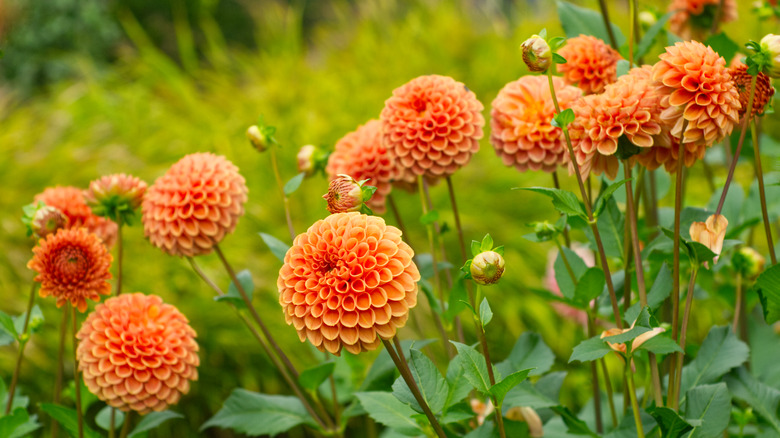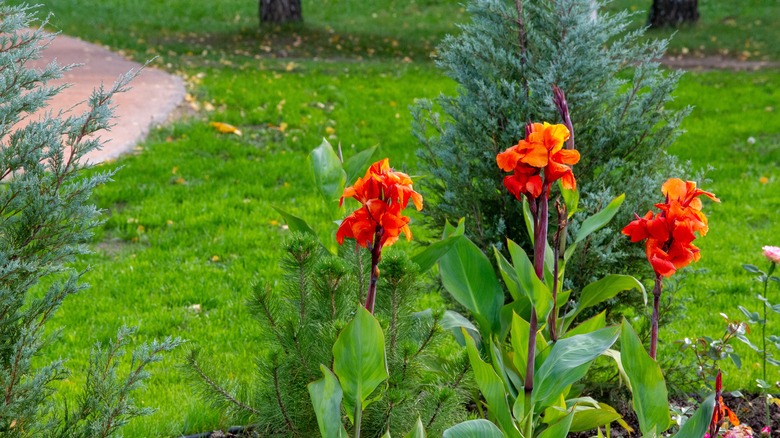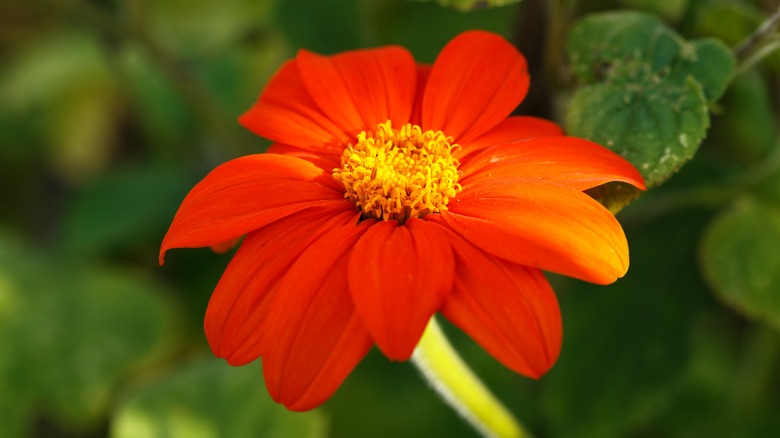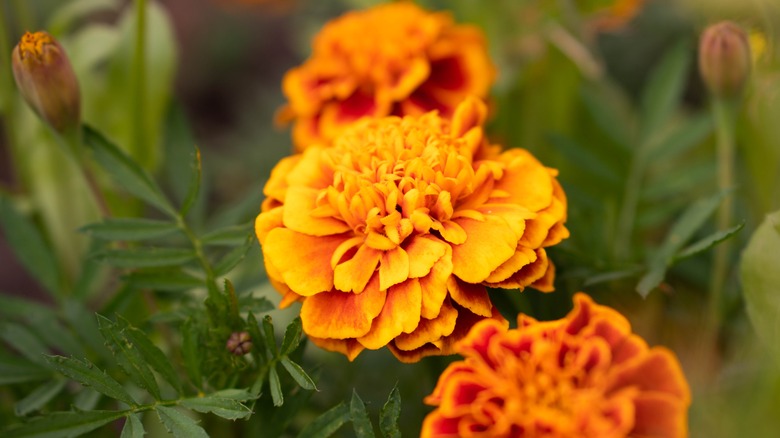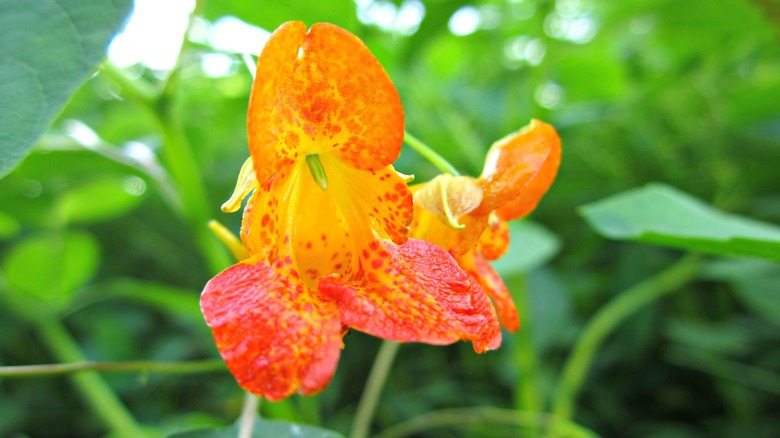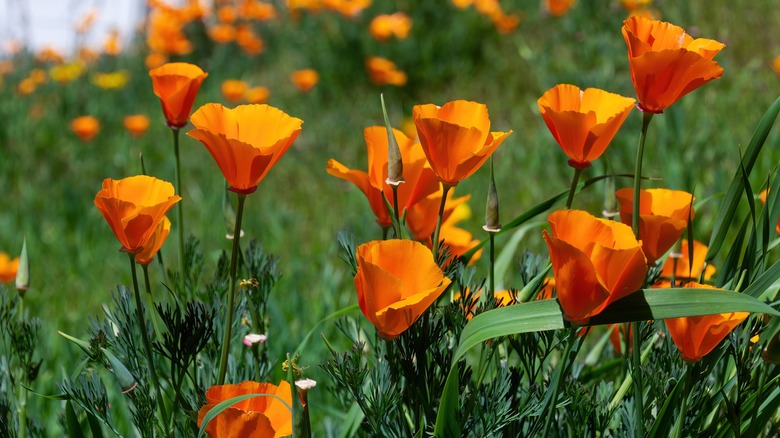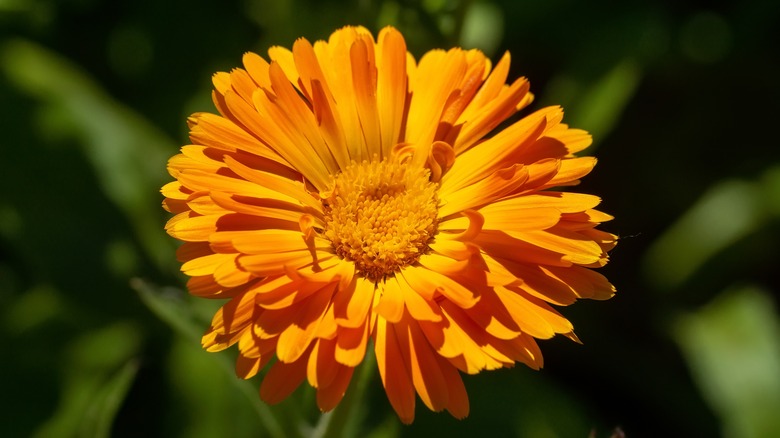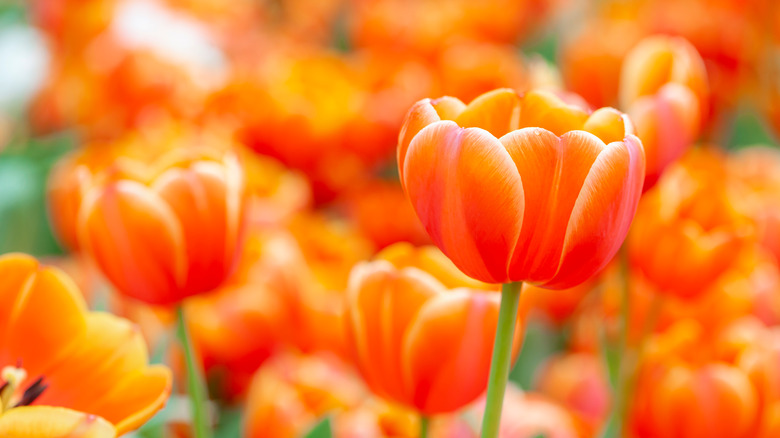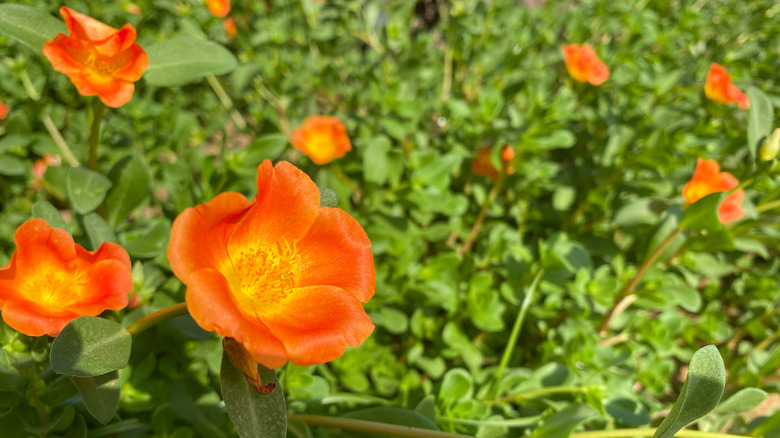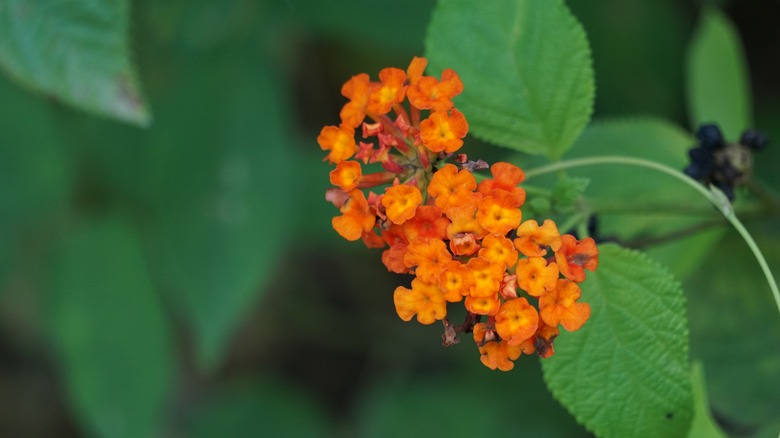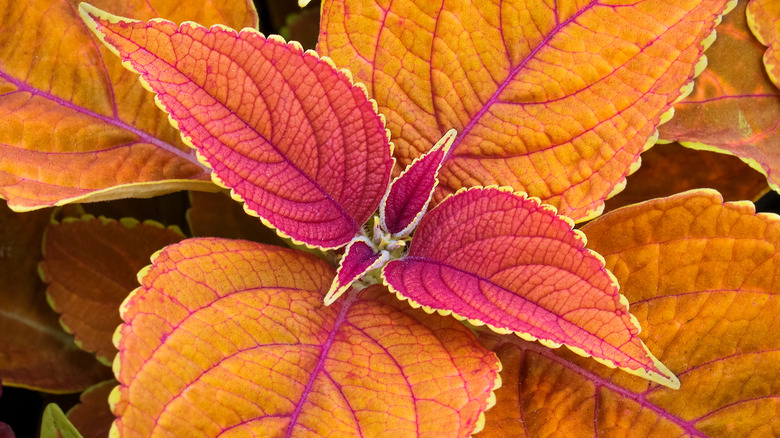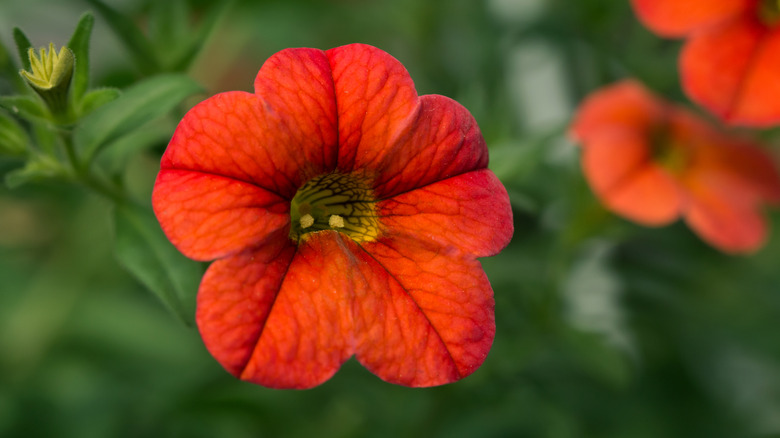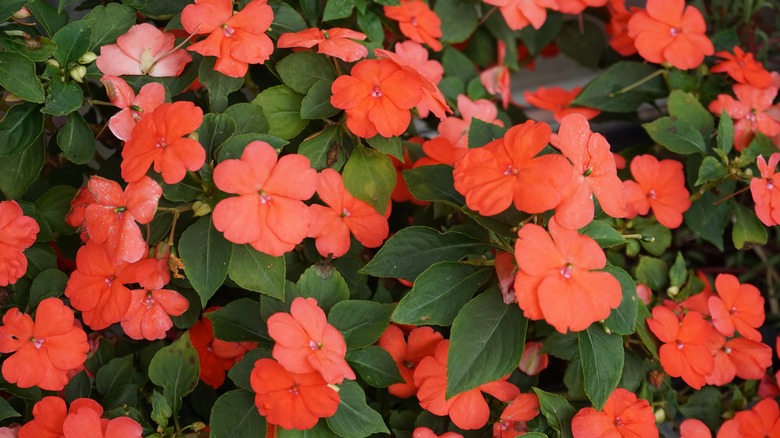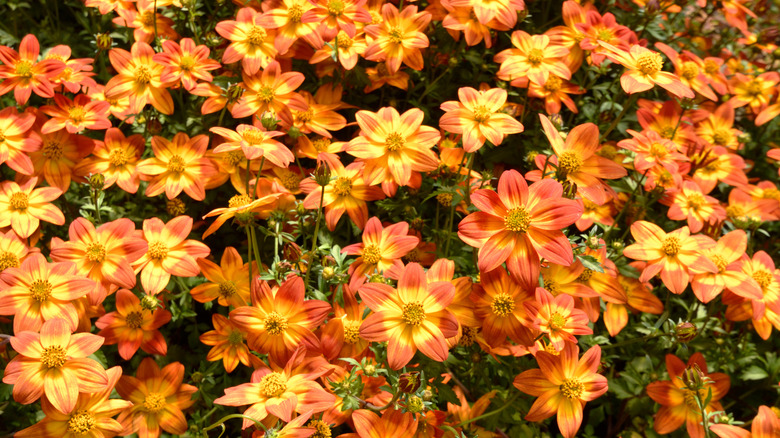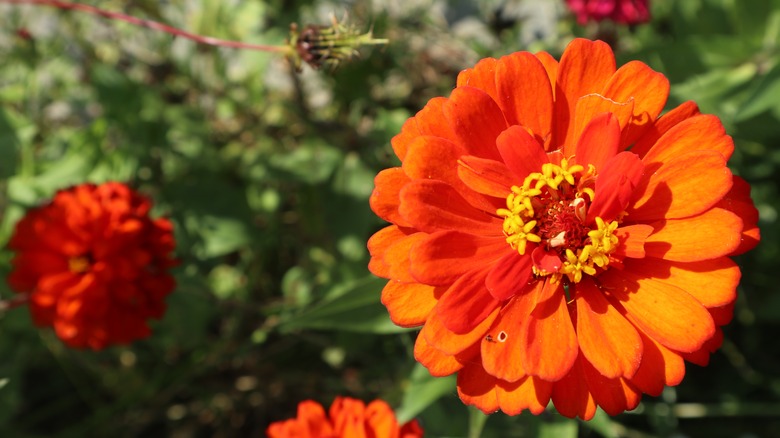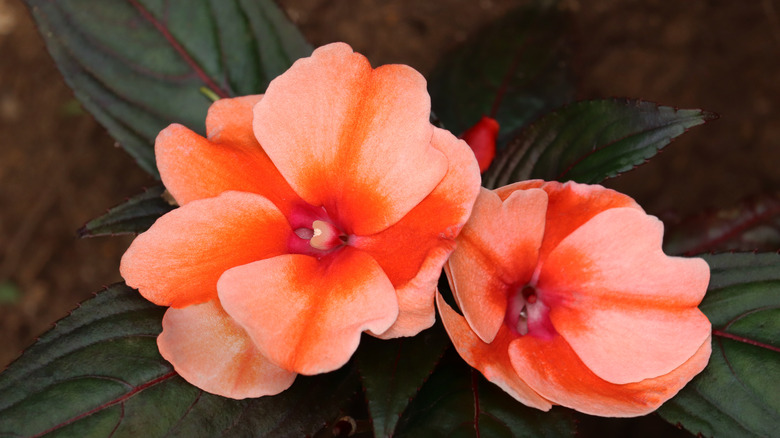15 Annuals That Bloom With Striking Orange Flowers
Gardens are one of the many things that can bring joy into your life, especially if you have a green thumb. They give you complete control by deciding what fertilizers and pesticides to use, whether you're growing fruits, vegetables, flowers, or all three. In addition, planting flowers in your vegetable garden is a great way to spruce up the look and incorporate fun and vibrant colors. According to The Micro Gardener, flowers can provide many benefits to your garden, such as limiting the number of weeds that grow, providing shade to other flowers or ground-growing veggies, and controlling pests and diseases.
If you enjoy the look of flowers in your garden but tend to stick with common flowers such as roses, daisies, and sunflowers, this is your sign to expand your garden. Annuals are the best flowers for your garden to start with because they live through an entire life cycle, meaning they die off at the end of their season, per Aggie-Horticulture. It's the best way to try out a new color or plant a new type of flower. We've gathered 15 different annual orange flowers you can grow to give your landscape a fresh pop of color.
1. Toucan dark orange canna
Toucan canna flowers (Canna generalis 'Dark Orange') add the perfect orange touch to any garden. They have delicate dark orange petals that sit atop long, thick green stems surrounded by large, pointy leaves. Toucan cannas are perfect for growing outdoors and indoors; according to Garden Center Marketing, they can tolerate heat and humidity very well.
Bloom Season: Late summer to early fall
USDA Growing Zone: 8 to 11
Growing Conditions: Full sun to partial shade
Soil Type: Well-draining
Size: 2 to 4 feet tall
2. Mexican sunflower
Mexican sunflowers (Tithonia rotundifolia) are smaller than your average yellow sunflower; they have droopy petals that grow out of the stem with a bright yellow center. Growing in the Garden states that they originate from Mexico and Central America and can be grown in warm climates in USDA zones 2 to 11. However, they're heat and drought-tolerant and need lots of sunshine, so they're best grown outdoors.
Bloom Season: Middle of summer to fall
USDA Growing Zone: 2 to 11
Growing Conditions: Full sun
Soil Type: Well-draining
Size: 4 to 6 feet tall
3. Marigolds
Marigolds (Tagetes) are one of the best flowers to grow for summer that will last through fall and add a pop of color to your garden as everything else changes. They feature gorgeous clusters of orange petals that resemble carnations and grow on a spikey-leaved bush. Folks should plant marigolds in well-draining soil, states Almanac. They can resist high temperatures, making them great plants to grow in hot climates.
Bloom Season: Summer to fall
USDA Growing Zone: 2 to 11
Growing Conditions: Full sun
Soil Type: Moderately fertile, well-draining
Size: Up to 3 feet tall
4. Orange jewelweed
Orange jewelweeds (Impatiens capensis) are smaller orange flowers that can get lost in the bush they grow on, but they're great for adding flare to your garden. The flowers can grow sparingly, but you can plant them together to get more blooms. Their bright foliage attracts hummingbirds and bees, per Illinois Wildflowers, which will enhance the feel and look of the garden.
Bloom Season: Spring
USDA Growing Zone: 2 to 11
Growing Conditions: Partial sun to partial shade
Soil Type: Moist, fertile, and well-draining
Size: 6 to 24 inches
5. Poppy
Poppies (Papaver) have scalloped petals and a thin stem that grows in a mass group. According to Utah State University, poppies love the sun, so when choosing a place to plant them, pick a spot that gets sunshine. When planted on the last frost date, they'll bloom beautiful orange flowers in the late spring ready to be picked and given as gifts or shown off in every room in the house.
Bloom Season: Late spring to early summer
USDA Growing Zone: 8 to 10
Growing Conditions: Full sun
Soil Type: Fertile, well-draining
Size: 2 to 3 feet tall
6. Lady Godiva
Orange Lady Godiva (Calendula officinalis) is a type of marigold with similar features to daisies; it has various bright orange petals piled on top of one another. Lady Godivas also grow on large evergreen bushes with many green pointy leaves. Plant the seeds in a sunny to partially shady area to get the best growth out of them, claims Plant Addicts.
Bloom Season: Early spring to fall
USDA Growing Zone: 7 to 11
Growing Conditions: Full sun to partial shade
Soil Type: Well-draining
Size: 10 to 16 inches tall
7. Tulip
Tulips (Tulipa spp.) are well-known in the flower world for their stunning colorful foliage that could light up any garden. The orange petals enclose the center and open up when the sun shines on them. They're the perfect flower for spring, notes Almanac; they tolerate the cold winters, so if you plant them in the fall, they'll bring color to your garden by early to late spring.
Bloom Season: Spring
USDA Growing Zone: 3 to 8
Growing Conditions: Full sun
Soil Type: Well-draining
Size: Up to 2 feet
8. Mojave tangerine purslane
Mojave tangerine flowers (Portulaca umbraticola) boast orange petals with a yellow center on a forest green bush with multiple oval leaves. They look perfect along a walkway for visitors to stop and admire them or in a pot by the front door ready to be the talk of the night. English Gardens claims Mojave tangerine flowers are low maintenance and can withstand heat, droughts, and minimal water.
Bloom Season: Late spring to early fall
USDA Growing Zone: 10 to 11
Growing Conditions: Full sun
Soil Type: Well-draining
Size: 4 to 8 inches tall
9. Lantana
Lantana plants (lantana camara) bloom uniquely with five smaller flowers that gather as a bunch, creating the illusion of one single flower. This plant is low maintenance and can bear poor soils as long as it's well-draining, per Missouri Botanical Garden. Display them in planters just outside the window to get a glimpse of them throughout the day — their lobed petals will bring a smile to your face.
Bloom Season: Summer to fall
USDA Growing Zone: 10 to 11
Growing Conditions: Full sun
Soil Type: Slightly acidic, well-draining
Size: 5 to 6 feet tall
10. Coleus
Coleus (Coleus scutellarioides 'Rustic Orange') is a large orange-leaved plant that can grow in a garden or a container. For coleus to thrive, place it in a shady area. Try keeping the soil moist but not wet by watering it a few times a week; you don't want the roots to be soaked and start molding, notes Nana's Bloomers.
Bloom Season: Late summer
USDA Growing Zone: 9 to 11
Growing Conditions: Sun to partial shade
Soil Type: Well-draining
Size: 18 to 24 inches tall
11. Superbells tangerine punch calibrachoa
Tangerine punch plants (Calibrachoa hybrid) have stunning orange petals with a deep red center that are perfect for planting in your garden. They grow along an evergreen bush, blooming in every spot possible. Plant Addicts states that tangerine punch plants are best grown outdoors because they'll receive more sunlight and water.
Bloom Season: Spring to fall
USDA Growing Zone: 9 to 11
Growing Conditions: Partial to full sun
Soil Type: Well-draining
Size: 6 to 12 inches
12. Impatiens
Orange impatiens (Impatiens walleriana rockapulco orange) resemble mini roses with numerous soft round petals and big green leaves. They can be grown in containers to create a neat bed of impatiens or directly in the garden in unused space. The University of Minnesota Extension claims impatiens are easy to grow and care for.
Bloom Season: Late spring to fall
USDA Growing Zone: 2 to 11
Growing Conditions: Part to full shade
Soil Type: Moist, well-draining
Size: 10 to 20 feet tall and 12 to 24 inches wide
13. Campfire fireburst
If a flower could be sassy, it would be a campfire fireburst (Bidens hybrid) due to this flower's red-orange needle-like petals and a small yellow center. It'll make heads turn in any sunny area, and you can pair it with evergreen shrubs to make it stand out. Daves Garden states that this flower is easy to care for; it requires full sun and minimal watering to thrive.
Bloom Season: Late summer to mid fall
USDA Growing Zone: 9 to 11
Growing Conditions: Full sun
Soil Type: Slightly acidic
Size: 6 to 12 inches tall
14. Zinnia
Orange zinnias (Zinnia elegans) are bright flowers with overlapping thin petals that grow sparingly on a shrub. According to Almanac, zinnias can bloom either with a single row of petals, with numerous rows where the center is invisible, or with many rows where the center is slightly visible. They bloom fast, and since their stems grow up to 12 inches, they can be put in a vase to make for a great centerpiece.
Bloom Season: Summer
USDA Growing Zone: 3 to 10
Growing Conditions: Full sun
Soil Type: Organic soil, well-draining
Size: Up to 12 inches tall
15. New Guinea impatiens
Part of the impatiens family, the New Guinea variety (Impatiens hawkeri) can change the look of your yard. It blooms with deep orange petals surrounded by thick green leaves like regular impatiens. You can place them around your garden or plant them in a pot indoors for a pop of color, states Epic Gardening. If you fall in love with their look, you can cut them back and they'll rebloom.
Bloom Season: All
USDA Growing Zone: 10 to 12
Growing Conditions: Partial to full shade
Soil Type: Well-draining
Size: 12 to 18 inches tall
